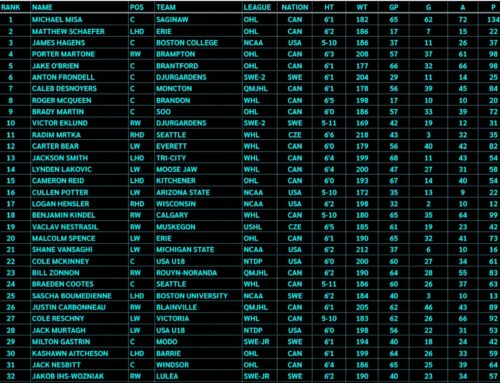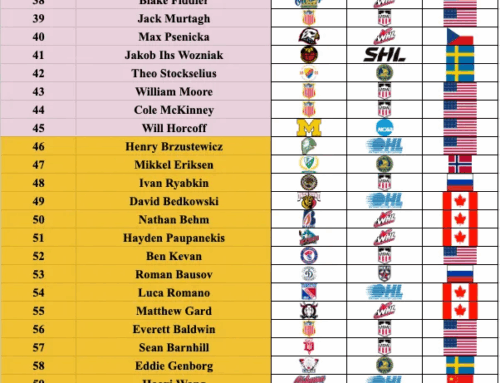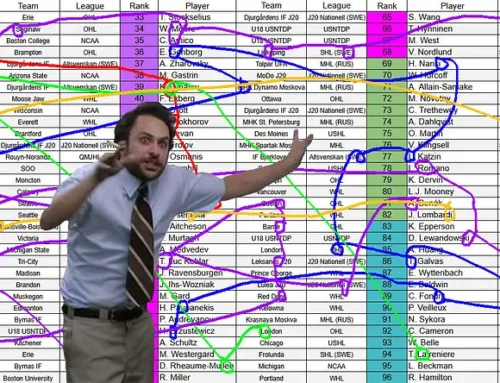Rasmus Dahlin: The Good, The Bad, The Buffalo
Tony Ferrari
2021-04-07
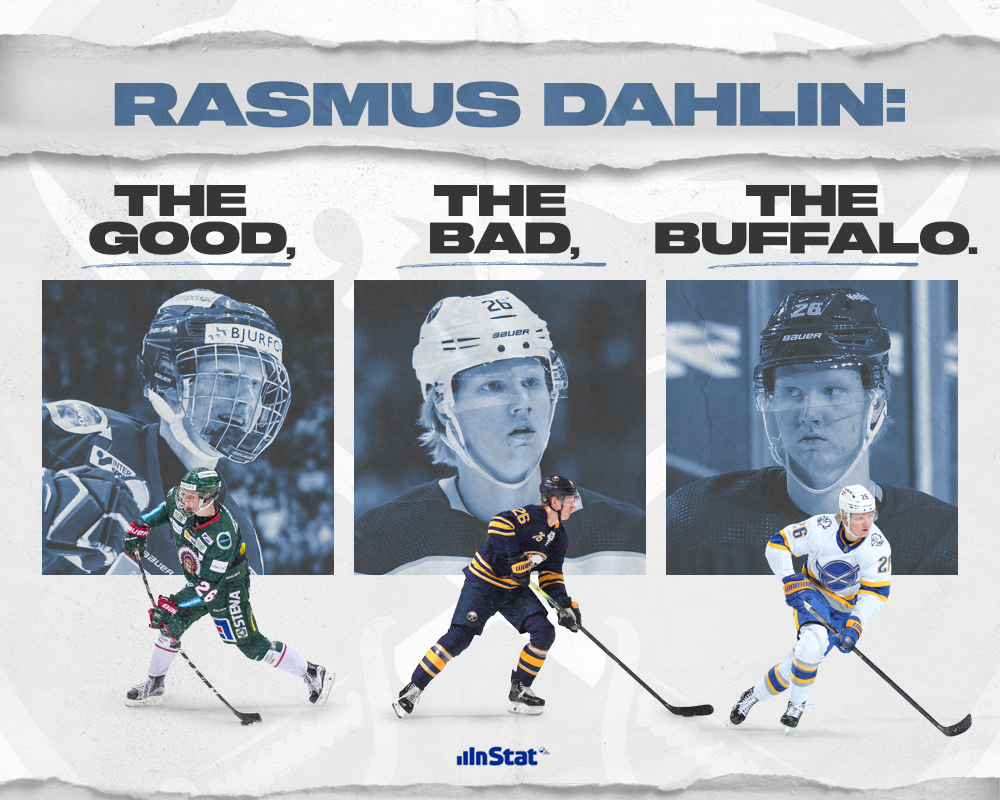
Image courtesy of Andrew Armstrong
The NHL is ushering in a youth movement on the blueline with names like Cale Makar, Quinn Hughes, Miro Heiskanen, Adam Fox. Once thought to be the headliner of the group, Rasmus Dahlin has been mentioned less and less with them recently. Dahlin was touted as the next great defender in the game. Norris Trophy wins were basically expected. Unfortunately for both Dahlin and hockey fans everywhere, that hasn’t been the case quite yet. The young Swede has time, still just 20 years old, and his raw talent is still bursting at the seams. The problem is that this season has been about as successful as General William Hull’s attempted invasion of Canada during the War of 1812.
Quinn Hughes. Cale Makar. Rasmus Dahlin. Miro Heiskanen. Adam Fox.
We are entering a golden age of young defensemen. This is going to be fun.
— Tony Ferrari (@theTonyFerrari) September 3, 2020
To figure out what happened, I went back and watched eight games from his draft year, rookie year, and this year. I dove into other tape as well such as reviewing all of his points in those three years. The base takeaways were that he was a deserved first-overall pick while playing with Frölunda in 2017-18. He had some issues defensively that were not being talked about and could have led to some worries but they weren’t anything that would have caused any wavering in regards to him being atop the draft board. His rookie season in 2018-19 with Buffalo was encouraging and he showed a ton of promise. The skills that he displayed at the SHL level translated well. Although watching the Sabres was tough, there was a lot of hope emanating from the talent of their recent top picks in Jack Eichel and Dahlin himself.
The pain really started when watching Dahlin and the Sabres from this season. Mental, emotional, and even physical pain have all been inflicted on the Buffalo Sabres organization and fanbase. COVID hit them multiple times this season, taking both former head coach Ralph Krueger and interim head coach Don Granato off the bench this season. Players such as Rasmus Ristolainen among others have caught COVID-19. Ristolainen was hit particularly hard by COVID-19 and as we’ve seen with other people, athletes and non-athletes, the effects of a novel coronavirus can last well after the person is ‘healthy’. As alluded to, they have also had an in-season coaching change whilst in the middle of a losing streak of epic proportions spanning 18 games before ending it a week ago – Wednesday, March 31st – and they’ve done well to win three of four since, with Dahlin showcasing what makes him special.
Those issues are just the icing on the cake, except the cake is a turd hidden in icing and Buffalo just can’t seem to stop eating. If the first question to be answered for the Sabres as the season winds down is ‘What happens with Jack Eichel?’, the second question has to be “What is Rasmus Dahlin and have we ruined him already?”. Neither question is going to be fun to answer and the Eichel one is likely not going to be in their control as the frustrated captain has been the topic of many trade discussions. The Dahlin question is going to be an interesting one and it requires some retrospective analysis of Dahlin through the years and a look at what needs to change, so let’s get into it.
Rasmus Dahlin the Draft Prospect
Not every draft is made equal. Following the 2017 draft which featured Nico Hischier and Nolan Patrick atop most boards, 2018 was supposed to return to the level of the previous two drafts. Connor McDavid (2015), Jack Eichel (2015), and Auston Matthews (2016) were all looked at as franchise-altering players and Rasmus Dahlin was viewed as the defender in that tier that everyone had been waiting on. At 6’2″ and 181lbs, he had the frame teams desired. His dynamic skating and offensive prowess led to near record-breaking production with 20 points in 41 games at the Liiga level.
Let’s look at what made him such a special prospect while playing with Frölunda in the SHL. Dahlin showcased exceptional ability as a skater and the unique blend of mobility and puck skills had scouts and general managers drooling. Meshing speed and agility along with elusiveness and deception, the young Swede was able to carve SHL teams as both a 17 and 18-year-old. He evaded pressure against men with ease, slipping forecheckers and defensive coverages through the neutral zone. Transitioning the puck up ice as an 18-year-old against men at a high level, Dahlin’s mobility was at a level that is seldom seen from blueliners. When the puck was on his stick, he became a magnet for opposing players, drawing them into his space by holding onto the puck a few extra seconds before snapping a pass to a teammate with extra space.
As an offensive player, Dahlin seemed to be thinking a step ahead of the players who were thinking a step ahead. The 2018 top prospect was able to open passing and shooting lanes with his lateral mobility and exploiting the lanes that he creates. He possessed a wicked wrist shot and wasn’t satisfied taking shots from the right point. He penetrated the offensive zone routinely, getting into the faceoff circles and the slot to take many of his shots. He was able to get 31.3% of his shots from the high danger area (home plate) and when looking exclusively at the shots he did take from the blueline, 52% of them came from between the faceoff circles, the most dangerous spot on the ice if you are shooting from distance. His tendency for getting to that high slot position was a factor of him staying fluid and mobile along the blueline. All of this factors into his ability to open lanes all over the ice but specifically in the offensive zone.
On the powerplay, Dahlin was a freak. The combination of his skating and puck skill made him a lethal threat from the blueline who could make a break inside at any time. With the added space due to the man advantage, Dahlin’s ability to manufacture space with his feet was admirable. Dahlin saw through layers, finding teammates that could have only dreamed of receiving a pass had it been anyone else. Whether it was a north-south or east-west, Dahlin could do it all.
His defensive play wasn’t perfect but he was able to utilize his skating and anticipation at a very high level. There were times, especially in sustained zone pressure, where he would lose his positioning trying to jump on a loose puck or cut off an opponent’s skating path. He showed a quickness about him when defending odd-man rushes, staying patient in the passing lane and before seemingly instantaneously striking the puck and quelling the offensive chance. He showed a fundamental physicality that projects well. He was able to pin attackers after angling off and he did a decent job of clearing the net-front considering his age. Defensive play was certainly the area that he needed to work on most but he progressed throughout the season and drove Corsi results to the tune of 60.34%, second among all defensemen in the SHL with at least 10 games played, regardless of age. A willingness to engage physically was a welcome sight at times as he fought through strength disadvantages with good body positioning and the confidence to put his hands in an attackers chest if needed.
The hype around Dahlin during his draft season was well deserved. Dahlin is an exceptional skating defender who has on-ice awareness and the ability to drive shot differentials overwhelmingly positively. He finished one point behind Victor Hedman’s record for draft-eligible scoring but played in two fewer games giving them both a .488 points-per-game. No matter the metric you use or the video you digest, Dahlin was every bit of a first overall pick who should change a franchises fortunes at the NHL level.
Dahlin’s Draft-Eligible Strengths: Skating and mobility, anticipation and play reading ability, elusiveness, offensive dual-threat, dynamic puck skills, transition game, rush defense, confidence, play driving ability
Dahlin’s Draft-Eligible Areas to Improve: Physical strength, net-front clearing, stagnant defensive play
Rasmus Dahlin the NHL Rookie
Coming into his rookie season, Dahlin was joining a Buffalo Sabres team that finished the prior season with 62 points and a 25-45-12 record to finish in the basement. With Jack Eichel entering his fourth season, first as captain, and the addition of Dahlin, Sabres fans were starting to see the light at the end of their never-ending rebuild tunnel. As a team, they improved by 14 points in the standings and picked up eight more wins overall. Things looked like they were at least on the right track, making a jump up the standings and looking like they finally had the building blocks to begin the build portion of the rebuild.
Dahlin began his rookie year playing 22:37 in his very first game as an NHLer and he didn’t look back. Dahlin came as advertised in just about every aspect of the game. He was a minute-eating play driver from the back end, averaging 21:06 a night and generating a 51.2% shot share. On a team that still finished in the bottom five of the NHL, Dahlin’s overwhelmingly positive results from a play driving and analytical perspective were encouraging. The Sabres blueline looked like it had its stalwart for years to come.
From a counting statistics standpoint, the young Swede was an absolute monster. Dahlin finished with the second-most points (44) and third-highest points-per-game (0.537) for an 18-year-old defender in NHL history. Only Phil Housley had more points and Housley and Bobby Orr had a higher points-per-game.
All the statistical success aside, seeing Dahlin playing his game and translating all of the mobility, skill, awareness and intelligence translate so quickly was a sight to behold. He was able to display the elusive footwork that earned him such high praise in the SHL and allowed him to push the pace of play. His ability to manipulate opponents with the puck on his stick, spawning room where there once wasn’t, was a noticeable trait that allowed for him to have such a good rookie year.
He was a fairly strong defensive player as well. He certainly had his hiccups as an NHL rookie but there were as many good moments as there were learning moments. He showcased the same patience and play reading ability. He had the wherewithal to attack the play when presented with the option and the confidence to follow through and turn play around efficiently. He certainly wasn’t a defensive wiz by any means but the traits of an excellent transitional defender and quality in-zone rearguard were all evident. Dahlin seemed to adjust to the pace of play at the NHL level fairly quickly and found himself as a Calder finalist, finishing third behind Vancouver center Elias Pettersson and St. Louis goaltender Jordan Binnington.
It’s safe to say that Dahlin’s rookie year in the NHL was a success. The translation of skills was evident in his rookie year and outside of a few things that you expect rookies to have issues with (strength, adjusting to pace initially), he seemed to be very much playing the same game with a bit more of an emphasis on using his partner than you’d see in the SHL. Nothing major to worry about especially considering he was able to showcase his skill leading to production.
Dahlin’s Rookie Year Strengths: Skating and mobility, anticipation and play reading ability, elusiveness, offensive dual-threat, dynamic puck skills, transition game, confidence, play driving ability
Dahlin’s Rookie Year Areas to Improve: Physical strength, net-front clearing, stagnant defensive play
Rasmus Dahlin Today
Entering his third NHL season, Dahlin was looking poised to breakout and looking to announce himself as one of the truly elite young defenders in the game. The Buffalo Sabres looked like they were trying to improve the roster around Dahlin and Eichel with the additions of 2018 Hart Trophy winner Taylor Hall and six-time 30-goal scorer Eric Staal who also has a Stanley Cup on his resume. With regression to the mean expected after an absolutely terrible season for Jeff Skinner, the Sabres must have felt fairly happy with the fact that they had some talent upfront to surround Eichel. On the back end, the Sabres added players like Brandon Montour, Colin Miller and Henri Jokiharju since 2019. The Sabres seemed to have a framework for what looked to be their first competitive roster since 2011-12 when they finished three points out of a playoff spot. They may not have been expected to make the playoffs, but they expected to be on the cusp and playing meaningful games past the trade deadline.
Then… the season happened.
As previously mentioned, the team has had anything that could go wrong, go worse than ever imagined. From injuries to bad bounces, this year has been filled with trouble. They’ve had multiple COVID-19 situations including former coach Ralph Krueger and interim head coach Don Granato both spending time on the COVID-list, with Krueger having a tough go with the virus. Players have been on and off the COVID list as well, including Dahlin himself who revealed that he was a close contact, not a positive test.
The most concerning part of the season for Dahlin was that his play of the ice has cratered a bit. To figure out why, there must be a multi-level analysis done on the Sabres and Dahlin himself. Thankfully, David St-Louis from Elite Prospects Rinkside did part of that work for us in his excellent systems analysis of the Sabres under Krueger and what could be done on a macro level to help improve the team in the long run. I encourage you to go check that article out as David is one of the best in the business but this tidbit stuck out to me and confirmed some of the concern that grew while watching the tape from this season.
Krueger’s tactics were quite standard. You had the 1-2-2 offensive zone forecheck, the 1-2-2 neutral-zone forecheck, and the slot-protecting defensive zone structure. Most of those systems erred on the passive side. The forechecking F1 (the first forward on the forecheck) would often pressure alone, detached from the formation, as the F2 (the second forward on the forecheck) would only engage if the team had a clear chance at stealing possession. And in the defensive zone, the Sabres didn’t pressure the top of the zone as hard, keeping their F1 in and around the slot when the puck moved high.
With the limited time he has to make changes to the structure, Granato should probably concentrate his efforts on involving his defencemen on the attack more.
David’s observations when it comes to their systematic play align with what I’ve seen as well. The note about involving defenders as well is something that should be prominent here. The fact that the Sabres seemed to want to get the puck to their forwards as quickly as possible, have them work passes up through the neutral zone and they seemed to be asking the roster to play with precision rather than pace. The first main issue with that are that the Sabres don’t have the roster to be able to rely on precision passing and utilizing forwards in transitions up ice as the sole course of action. The second issue is that this style of play doesn’t encourage or allow for defenders who have the mobility and skill to move the puck up ice on their stick. Dahlin is that defender.
Dahlin, like much of the Sabres roster, has seemed to lose their confidence in their game completely this season. The usually aggressive Dahlin has shown far more hesitation this season. Whether it be in his pinching at the blue line or his gapping up in the neutral zone, Dahlin’s split-second hesitation has seemed to affect his ability to play to his full capacity. That hesitation can be a death note for defenders, especially defenders who play an uptempo attacking style of defense, as Dahlin does. Due to that, he’s wound up on the wrong end of highlight reels a number of times this season.
Unfortunately, this season has taken a toll on the Sabres young players, including Eichel and Dahlin, the franchise cornerstones. A confidence issue leads to hesitation, leading to mistimed and unaware plays that get you burned. Everyone on the Sabres has been burned so far this season. Dahlin’s raw tools – skating and mobility, quick hands, passing, and his shot – all have shown up from time to time this season but the young Swede hasn’t been able to pull them all together this year.
Dahlin’s Year Three Strengths: Skating and mobility, offensive dual-threat, dynamic puck skills, transition game
Dahlin’s Year Three Areas to Improve: Net-front clearing, willingness to engage physically, stagnant defensive play, anticipation and play reading ability, situational awareness, confidence
What’s the Deal with Dahlin?
With tape reviewed and sadness having taken over, the next step in the process of evaluating what happened to Rasmus Dahlin is to take a look at some numbers courtesy of Evolving Hockey. Let’s take a look at some of Dahlin’s on-ice results at even strength. The first thing we notice is that his numbers are down across the board. Playing on a team that lost 18 straight up until last week will do that to you. The game-changing ability of Dahlin hasn’t been enough to keep his head afloat in year three, unfortunately.

All data courtesy of EvolvingHockey.com
One thing to note when looking at this data is that he is even underperforming what is to be expected, after routinely outperforming the data by a small, reasonable margin in his first two seasons. Looking at his recent drop in GF% (goals for percentage), there is a massive drop off from year-to-year but he is also underperforming his xGF% (expected goals for percentage) by ~18 percentage points. That massive discrepancy is likely a factor of the team’s putrid season but it could also be an indicator that Dahlin’s season as a whole has been off the rails in general, which has also been the case. This data set also gives us a pretty grim view of how even with a slightly lower CA/60 (Corsi Against per 60 minutes), his overall CF% has gone south as well. This indicates that while his shot prevention has improved marginally, his offensive game has descended into uneasy waters. His RAPM charts from the last three seasons bare out very interesting results as well, with Dahlin excelling on the powerplay but deteriorating in general from his rookie season to now.

All data courtesy of EvolvingHockey.com
GAR (goals above replacement) is a metric that attempts to assign a total value to each player, which represents how much that player contributed to their team in a single number. This single number is comprised of multiple components that are ratings for each area of play within a given sport. As we are seeing analytics become more mainstream and the broader hockey fanbase is beginning to understand and inquire about ‘advanced data’, metrics such as GAR do a good job of giving a broader picture about a player’s contributions. Diving into Dahlin’s numbers in this area again cause concern as the stark downward trend continues as Dahlin went from being a well above average contributor in his rookie season, tops among 18-year-old players and top-10 among U20 players league-wide, to being bottom-five league-wide among the likes of Jack Johnson and Jacob Larsson this season. The most concerning part of the downward spiral are that the areas of his game that have suffered the biggest losses are his offensive impact. The highlighted columns below show not only his overall GAR but also his even-strength offensive GAR (EVO_GAR) and his power play offensive GAR (PPO_GAR). Anytime you go from an overwhelming positive to an overwhelming negative, there is cause for concern.

All data courtesy of EvolvingHockey.com
With downward trends virtually across all statistically categories carry over to his raw production. The promising young Swede went from 0.536 points-per-game as a rookie to then stepping up to an impressive 0.678, good for a tie of 20th league-wide amongst blueliners. This season, the number has cratered to 0.351 points-per-game which puts him right in line with teammates Brandon Montour and Rasmus Ristolainen. Almost halving his production rates from the year before, Dahlin is struggling to do the one thing that he’s always done.
Insert Sad Dahlin Offensive Clip from 2021
What to do with Dahlin
If Twitter is to be believed (it is not), the Buffalo Sabres should consider trading the struggling young blueliner before he loses all potential value and projection. He could be a reclamation project that turns into a legitimate NHL superstar due to his age, prior history and trajectory. The problem with this is that he was drafted three years ago and that would be incredibly early to move on from a player once held in almost the same regard as Auston Matthews in terms of prospect value. The package coming back to the Sabres would have to be borderline ridiculous to even consider, to be honest.

Graphic courtesy of StatsCentre (Stats as of April 6, 2021)
The question of ‘What do the Sabres do with Dahlin?’ should be an easy one. Don’t make any crazy moves, keep him in the fold, develop him and let him reach get back to his Norris calibre trajectory. Rasmus Dahlin is about to turn 21 years old on April 13th and he has put himself in conversations with the likes of Victor Hedman and Phil Housley regularly with his play and near-record setting performances in both his draft year and rookie season. This season has been an unmitigated disaster for both Dahlin and the Sabres. Nothing has gone right, and that may be an understatement. For any other team, writing this season off as a disaster pandemic season would be the perfectly reasonable course of action. Move on and just get it over with. The Sabres, because of their perennial basement-dwelling roster, have used up most of their excuses.
That is certainly not to say that they have any shot in the world at turning the season around and making a playoff push. They might as well be mathematically eliminated from the playoffs because that hope is gone. What they need to do instead is turn the keys to the bus over to their cornerstones. Eichel is out long-term unfortunately but that means giving the keys to players like Dahlin and 2019 first-round pick Dylan Cozens. Let Dahlin be Dahlin. Jack Han, formerly with the Toronto Maple Leafs in a player development, scouting, and analytics role as well as an assistant coach with the Marlies, recently wrote a bit about the topic of development in general and how to ruin a player with Patrik Laine, Shane Gostisbehere, and you guessed it, Rasmus Dahlin as inspiration. You’re encouraged to go read the piece and the rest of Jack’s newsletter as it will often make you a smarter hockey fan and analyst.
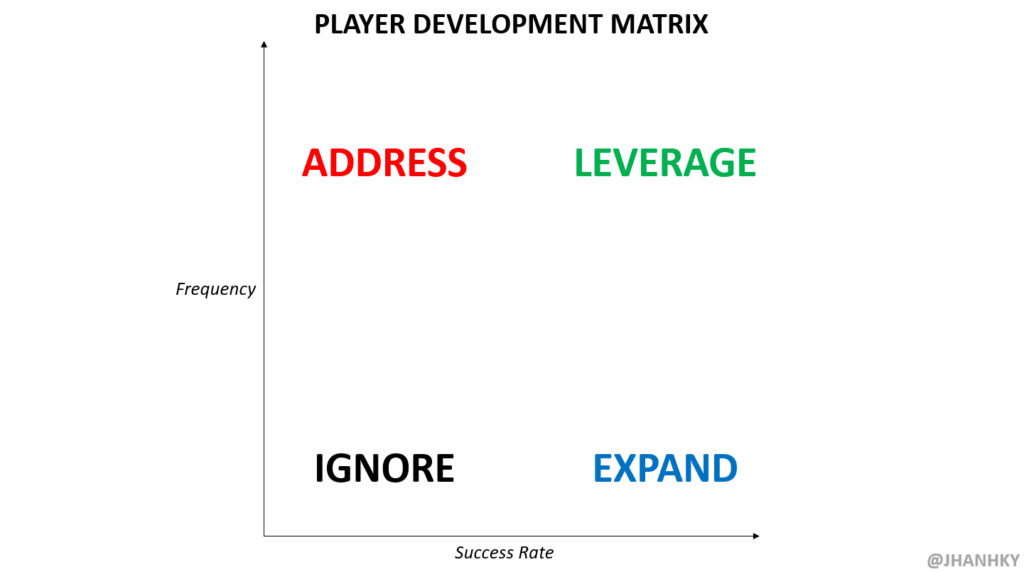
Graph courtesy of Jack Han’s Hockey Tactics newsletter.
The quick summation of the graph is that teams who want to develop a player to their fullest extent need to do a combination of things. In Dahlin’s case, the Sabres need to leverage what makes him special. Push him to utilize his skating, puck skills and offensive aptitude. Encourage him to carry the puck, push the pace and dare him to make the big play. There will undoubtedly be mistakes which is where they need to address them. Sit him down after a couple of weeks and go over the good and the bad. Find what worked and expand upon that. Maybe he could be doing a little thing a bit more often that will lead to those big plays. Identify what doesn’t work, go over why and look to work through the problem rather than solely focus in on it. There is also that ‘ignore’ in the low frequency/low success rate portion of the graph. That’s for the mistakes that are generally less common or atypical to the situations he will be in. Dahlin gets outmuscled a neutral zone puck battle? Okay, that sucks but you talk about how to avoid that situation or you just accept that sometimes that happens and the success in other areas are far more important. As the Sabres have seen during this recent brief stretch of winning hockey, when you let Dahlin do his thing, he’s pretty damn good at it. He had possibly his best game of the season recently against the New Jersey Devils, playing with confidence and swagger. Hockey needs more of THIS Dahlin.
At the end of the day, Rasmus Dahlin is a special talent. Even today, as we speak, he should be considered one of the most exciting and talented young blueliners in the game of hockey. The Sabres have seemingly asked Dahlin to be what he isn’t. The key to the situation will be embracing what the talent that he brings to the table can do at the NHL level and how to best put him in a position to succeed. You wouldn’t ask Gordon Ramsey to cook you Kraft Dinner so why would you ask an elite, puck rushing, offensively dynamic defenseman to defer to his teammates and play conservatively? Push him to be who he is, especially for the remainder of the 2020-21 season that has been lost due to the Sabres atrocious on-ice product. The Sabres need to champion his skillset. Let him ascend to the heights he’s been destined for since he was tearing up the SHL at 17 and 18 years old. Let Dahlin be Dahlin.
I hope you enjoyed the journey through Dahlin’s career so far and can understand what’s happened to this point and why there’s still so much story left to tell for the young stud defenseman. If you have any comments or feel compelled to discuss any part of the article, follow me on Twitter @theTonyFerrari! Thanks for reading!
All data is courtesy of InStat, EvolvingHockey.com, and Elite Prospects



